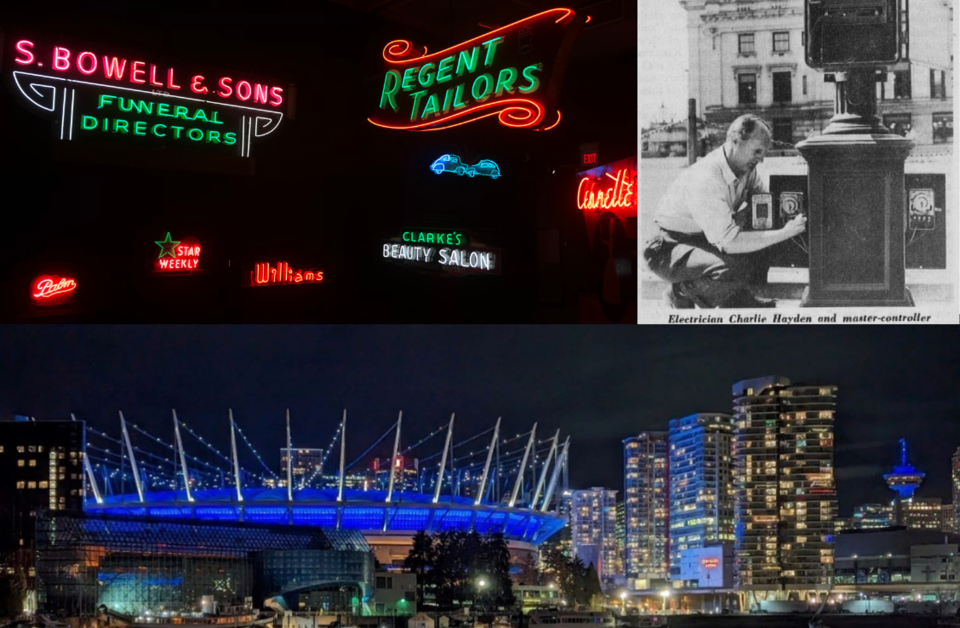Electric lighting is one of those inventions that seems mundane now, but was a big deal for people around the world.
The Canadian government actually lists two men born in what would become Canada as the inventors of the first electric light bulb, though others were experimenting; they sold their patent to Thomas Edison a few years later as he pushed his company's version.
Edison's patent came in 1880, and he began to commercialize the new product. In 1886, the City of Vancouver was officially founded, so light bulbs were a fairly recent invention at that time.
By 1914, lights and other uses for electricity meant huge electrical poles were built in Vancouver. They do not look safe by today's standards.
So here are some illuminating facts about lights in Vancouver.
1. 55,000 street lights
The city estimates there are about 55,000 streetlights in Vancouver. That's about one for every dozen people (without a few left in the dark).
2. All of the traffic lights in the city's core used to be controlled by a single lamppost
According to an old issue of The Buzzer, a single lamppost on Howe Street near the courthouse controlled all of the traffic lights in downtown Vancouver in the 1950s.
Pedestrians could hear a ticking sound if they stood nearby.
"If the ticking ever stops, look out!" states the article. "Like a heart quitting, it would create almost instant paralysis...all over downtown Vancouver traffic would bog down and clot."
Computer chips weren't an option in the 1950s, so inside was essentially a few clocks, "a box that ticks," and lots of wire. It was set up with some automatic systems (essentially alarms) that would switch the lights for the morning and evening commutes automatically.
3. You can see some city borders from the air
Because different municipal governments use different lighting systems, the colour of those lights help mark out the edges of those municipalities at night.
It's most striking around Burnaby (including the Vancouver-Burnaby boundary), as it was the first city to switch to LED lights in the region. Over time, as more cities switch, they'll likely all look the same, but they could look slightly different depending on the colour temperature.
4. Vancouver was a neon capital
For a while Vancouver was one of the neon capitals of the world.
The use of neon lights in the city's core was popular, to the point that it became a political point.
Everyone was using neon to advertise their businesses, services or anything else (in fact, it's one of the ways Jim Pattison grew his company). Some evidence of this remains; the museum had an exhibit for a while with some salvaged signs. There's also several signs along the Granville strip that are obviously from, or nods, to the era.
There's also the Bowmac sign on Broadway and many locals will remember the Only Seafoods sign.
The popularity of neon took a hit in the 1960s as criticism rose, calling it ugly, essentially. One neon sign manufacturer was quoted as saying the curtailing of neon signs would hurt business in the downtown core, and make the city too quiet.
5. Vancouver lights were part of a world record this year
Many may have missed it, but there was a huge (in a physical sense) world record set this year in Canada and several Vancouver locations participated.
As the Royal Canadian Air Force was turning 100 years old, dozens of landmarks were lit up to in honour of the anniversary.
They turned 56 recognized landmarks blue.
The record that was set was for the most landmarks lit in 24 hours on April 1.
There were actually hundreds of locations that were lit up in blue for the RCAF, but only 56 counted.
In Vancouver that included Vancouver City Hall, the Queen Elizabeth Theatre, and BC Place.
Guinness World Records (now owned by Jim Pattison's company) recognized the achievement with a certificate in June.



